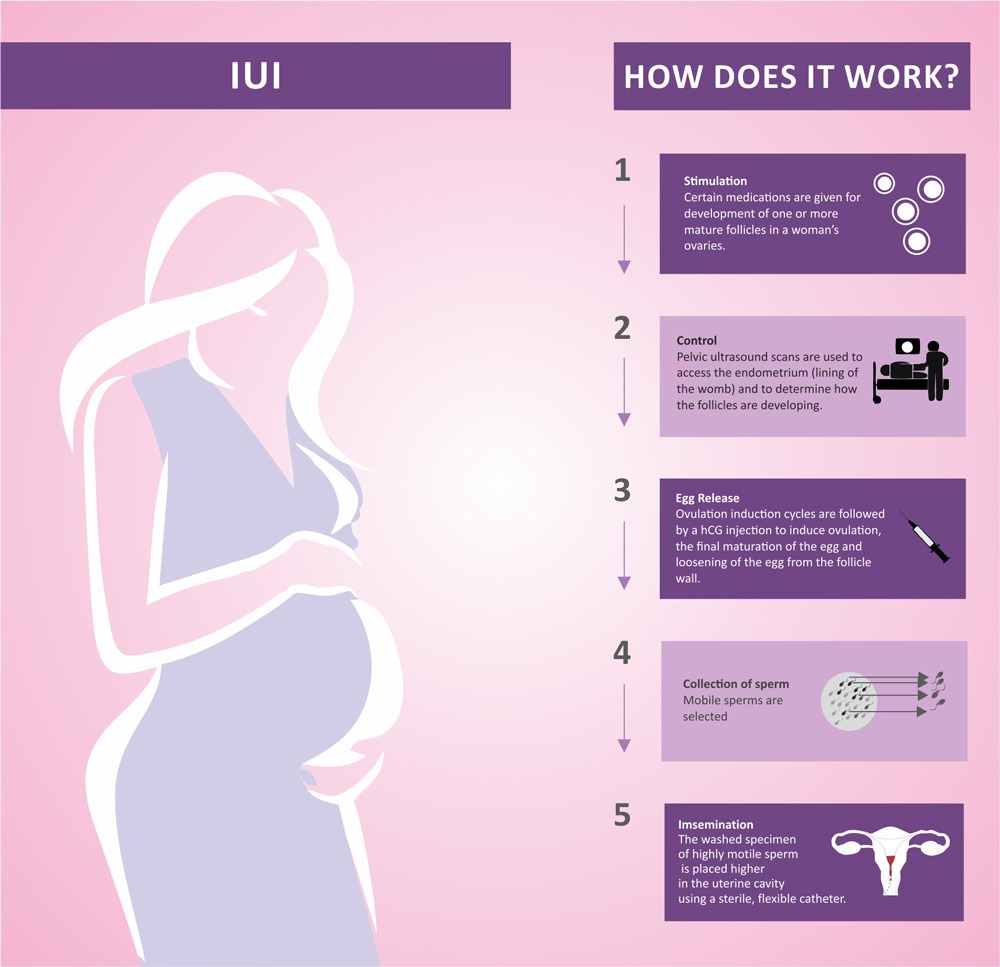
IUI – Intra Uterine Insemination
Intra Uterine Insemination or Artificial Insemination or Artificial Insemination using husband’s sperm (AIH) is a laboratory process where the fast moving sperm is separated from the more sluggish moving sperm and is deposited close to the woman’s womb close to the time of ovulation.
Intra Uterine Insemination (IUI) is the first step in fertility treatment and is a cost-effective method to enhance fertility in a woman with patent fallopian tubes.
OI with TI Step-by-Step Guide
Initial Consultation with Oasis Fertility Specialist



Ovarian Stimulation
Step 1 – Stimulation
Stimulation medications are given for development of one or more mature follicles in a woman’s ovaries.
Step 2 – Control
Pelvic ultrasound scans are used to access the endometrium (lining of the womb) and to determine how the follicles are developing. Blood tests may also be carried out to measure hormone levels and helps to determine when a women is most likely to ovulate (a woman’s most fertile time).
Step 3 – Egg Release
Ovulation induction cycles are followed by a hCG injection to induce ovulation, the final maturation of the egg and loosening of the egg from the follicle wall.
Step 4 – Semen Collection
A semen specimen is collected from the male partner after 2-5 days of abstinence from ejaculation.
Step 5 – Sperm Selection
The semen is “washed” in the laboratory (called sperm processing or sperm washing). The sperm is separated from the other components of the semen and concentrated in a small volume. Various media and techniques can be used for the washing and separation. Sperm processing takes about 30-60 minutes.
The more morphologically normal and motile sperm are selected for insemination.
Step 6 – Insemination
A speculum is placed in the vagina and the cervical area is gently cleaned. The washed specimen of highly motile sperm is placed higher in the uterine cavity using a sterile, flexible catheter.
Additional Information:
Why Intra Uterine Insemination (IUI)?
There are numerous reasons why a couple would get an Intra Uterine Insemination. If the male partner’s sperm count, motility or shape is less than adequate, IUI may give the sperm a better chance at meeting the egg. If a woman’s cervical mucus is scant or thick and tacky (ovulatory mucus is normally thin and stretchy), Intra Uterine Insemination will allow the sperm to bypass the mucus.
Steps in an IUI treatment
Step 1: Pre-investigation
Before subjecting a couple to Intra Uterine Insemination (IUI) procedure they are advised to undergo certain investigations to check the feasibility for the procedure.
The female partner is asked to undergo certain hormonal blood tests and the male partner is asked to undergo basic semen analysis. Both the partners are subjected to certain common tests like blood grouping, HIV, Hepatitis B & C, and blood tests for sexually transmitted diseases.
Step 2: Scans, Injections & Medicines
The female partner will be given tablets and hormonal injections based on the assessment by the doctors. There will also be scans (three at the maximum) to assess the time of ovulation
Step 3: Finalizing Dates
The tentative date for the IUI is fixed on the day of the last scan and IUI is executed accordingly.
How is the procedure done?Before the Intra Uterine Insemination, the sperm specimen will be prepared by the lab technicians. Once ready, the physician will introduce a speculum into the vagina to visualize the cervix. A mild cleaning solution may be used to clean the cervix and surrounding vaginal tissue. A small amount of the washed sperm will be drawn into a syringe with a tiny catheter attached. The catheter is passed through the cervix and then the sperm injected into the uterus. The catheter and speculum will then be removed and you may be asked to rest for a short period of time.
What is the success rate of Intra Uterine Insemination?
Some studies show only a 10% success rate (when using fertility drugs plus IUI), while others put the success rate closer to 20%. Age plays a big part in IUI success. In a study of IUI success for women over age 40, the findings showed a very low pregnancy rate. For women under age 40, the recommendation is three cycles of IUI, before moving onto IVF treatment. One study found that IUI success rates were 16.4% per cycle for the first three tries, or 39.2% if looking at all three trials together. However, for IUI treatments cycles 4 through 6, the success rate dropped significantly to only 5.6%. This steep drop after three unsuccessful tries at IUI is why moving onto IVF is recommended at this stage.
Notes
- Intrauterine insemination is associated with higher conception rates than Intracervical Insemination
- Fresh sperm is associated with higher conception rates than frozen/thawed sperm.
For more information regarding Intra Uterine Insemination, please visit the IUI FAQ page.





